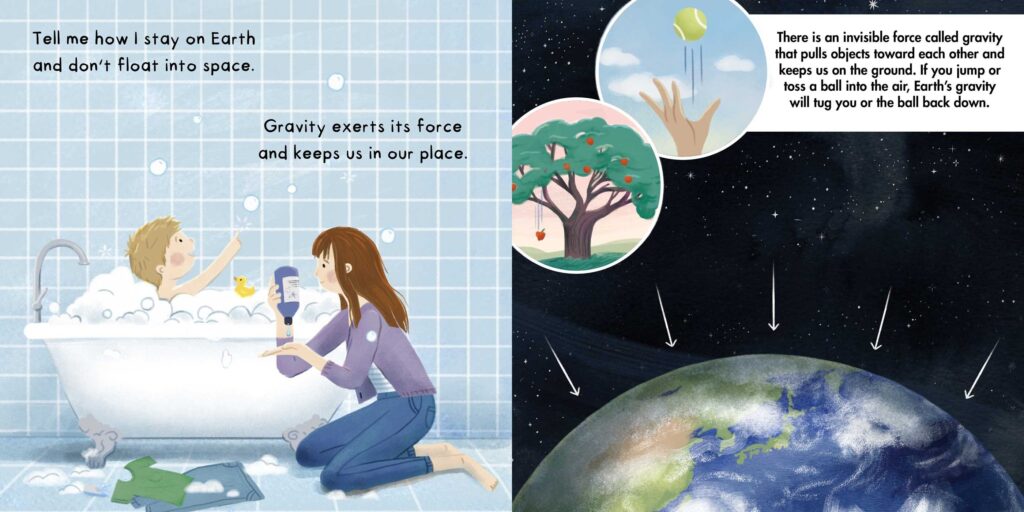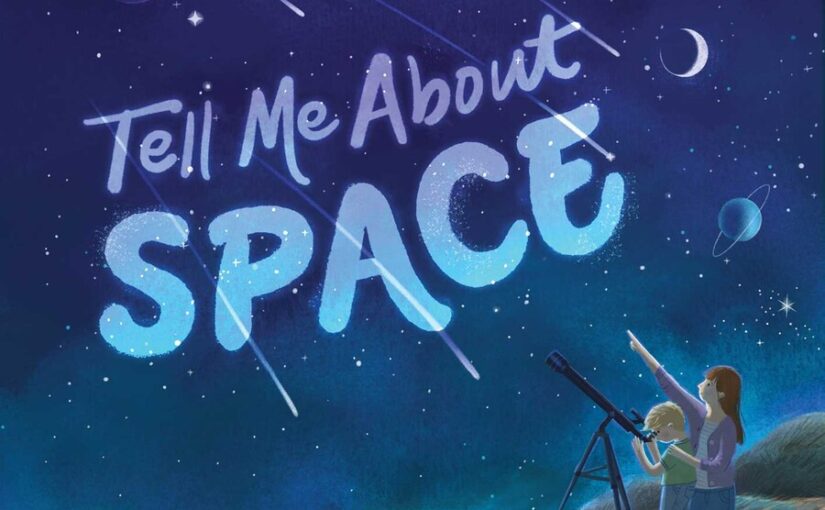One of my favorite family photos is of our oldest son, who was approximately 18 months old at the time, lying on his stomach while reading a board book. In that case it was one of the classic Eric Carle books in board book form, but it was the format of the book and not necessarily its content that captivated our child. The only constant about board books are their thick pages, which is just a defense mechanism against teething small creatures. Tell Me About Space is a board book, but it has more in common with the STEM-based books that we’ve previously talked about than the Carle book that our child was gnawing on.

Tell Me About Space operates at two different levels. When you open the board book you’ll see a soft illustration with a mom and her young son, both of whom are looking out the window as the sun sets. The boy is asking an innocent question that every child has about our planet and what happens in our neighborhood. He asks “what happens to the light?”, when the sun goes down and darkness falls.
The next page is where the soft STEM-magic and curious-minded kids will reap rewards. In big text, the same size that the question was posed in, young readers will see the answer to it. In this case we all know that it’s because the sun stays put and that it’s the Earth that spins, doing revolutions around the sun to create seasons. We just added the later part to our definition, the book doesn’t go that deep for budding scientists. However, in slightly smaller font, on that same page, young scientists will see a more detailed explanation about the misnomer of a “rising” or “setting” sun, as well as, what’s happening to the other side of the planet when we have night or daytime.
It’s the next page in Tell Me About Space that really hit home for us. When our eldest was about five years old he asked us the same question that the boy did in the book. Tell me why I’m standing still if Earth is constantly spinning around. When we were asked that question I knew that I had something to do with gravity. However, I didn’t have the immediate wherewithal to tell our child exactly why that’s the case. Using the same format as the first two pages the book tells us that everything is moving.

Again, my adult brain would say “so what”, everything is moving, but if everything is moving why don’t we all move around aimlessly? I know that gravity factors in there somewhere, but the book tells readers that because the Earth is always spinning at 1,000 miles an hour the movement can’t be felt because it’s constant. This leads logical and paranoid adults to think about what would happen if the world suddenly stopped rotating, and the subsequent tidal waves and chaos that would ensue.
The elephant in the room, gravity, rears its head on the next page. The other day I asked our children, now aged 14 and 12 why certain planets are different colors, and they couldn’t answer it. To be fair, many people couldn’t answer that question, but that’s only because they don’t actively think about it. This board book intended for young audiences, acknowledges why Mars is red and Uranus is blue, what constitutes the rings of Saturn, the presence of moons in the universe and more.
Tell Me About Space ends with the unspoken, obvious question for young people regarding the stars during the daytime. Those older readers will be able to tell you what happens to the stars, and with a little bit of prompting and logic; those younger readers will soon be able to tell you as well. The stars are still there, it’s just that the sun’s light drowns out the obvious fact that they’re still there, it’s just that the sun’s light is making
Tell Me About Space is by Lisa Varchol Perron with illustrations by Jennifer Falkner and is available on Little Simon, an imprint of Simon & Schuster Children’s Publishing.
There are affiliate links in this post.





 Facebook
Facebook Twitter
Twitter Flickr
Flickr GooglePlus
GooglePlus Youtube
Youtube